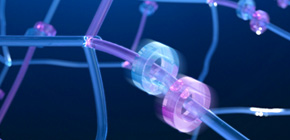
Elastic photoresponsive gels developed
New materials for artificial muscles and electrodes
A group of researchers led by Specially Appointed Professor HARADA Akira at the Project Research Center for Fundamental Sciences, Graduate School of Science, Osaka University developed hydrogel actuators containing cyclic polysaccharide cyclodextrin and photoresponsive molecule azobenzen (Azo) as molecules functioning as sensors and controllers. These high-toughness gel actuators bend, shrink, and extend according to the irradiation wavelength.
This team focused on host-guest interactions between αCD and Azo and reported about photoresponsive hydrogels reversely exhibiting contraction and expansion behaviors by changing the crosslink density of polymer chains through the suppression of the formation of the inclusion complex of αCD and Azo by photostimulation. In order to build a molecular recognition system, this group chose αCD as a host molecule and photoresponsive azobenzen (Azo) as a guest molecule.
αCD-modifying Azo formed a [c2]daisy chain in water. This group prepared the molecular actuators by crosslinking a CD derivative and TetraPEG through amide bond formation. [c2]AzoCD 2 hydrogel showed a stretching property, which was not possessed by conventional materials, due to the sliding motion of the ring and axial molecules. Irradiation with ultraviolet light and visible light caused [c2]Daisy chains to either contract or expand, leading to the production of hydrogel actuators driven by reversible structural change.
The material developed by this group shows a structural change through a sliding motion based on host-guest interactions between the photoresponsive molecule azobenzen (Azo) and cyclodextrin (CD). The stretching property of hydrogel presented a big deformation and functioned in wet- and dry-states due to its sliding motion. The production method of hydrogel is relatively easy, so it’s possible to have various combinations of CD and a guest component.
This hydrogel actuator’s drive mechanism is completely different from those of previously reported stimuli-responsive actuators driven by chemical and structural changes of stimuli responsive molecules. It is anticipated that photoresponsive elastic gel actuators will be used for the development of functional materials responsive to external stimuli such as oxidoreduction, electricity, and lyophobic changes as well as medical materials.
Abstract
Hierarchically organized myosin and actin filaments found in biological systems exhibit contraction and expansion behaviours that produce work and force by consuming chemical energy. Inspired by these naturally occurring examples, we have developed photoresponsive wet- and dry-type molecular actuators built from rotaxane-based compounds known as [c2]daisy chains (specifically, [c2]AzoCD 2 hydrogel and [c2]AzoCD 2 xerogel). These actuators were prepared via polycondensation between four-armed poly(ethylene glycol) and a [c2]daisy chain based on α-cyclodextrin as the host component and azobenzene as a photoresponsive guest component. The light-induced actuation arises from the sliding motion of the [c2]daisy chain unit. Ultraviolet irradiation caused the gels to bend towards the light source. The response of the [c2]AzoCD 2 xerogel, even under dry conditions, is very fast (7° every second), which is 10,800 times faster than the [c2]AzoCD 2 hydrogel (7° every 3 h). In addition, the [c2]AzoCD 2 xerogel was used as a crane arm to lift an object using ultraviolet irradiation to produce mechanical work.

Figure 1
Figure 2
Figure 3
Figure 4
To learn more about this research, please view the full research report entitled “ Fast Response Dry-type Artificial Molecular Muscles with [c2]Daisy Chains ” at this page of the Nature Chemistry website.
Related Link
